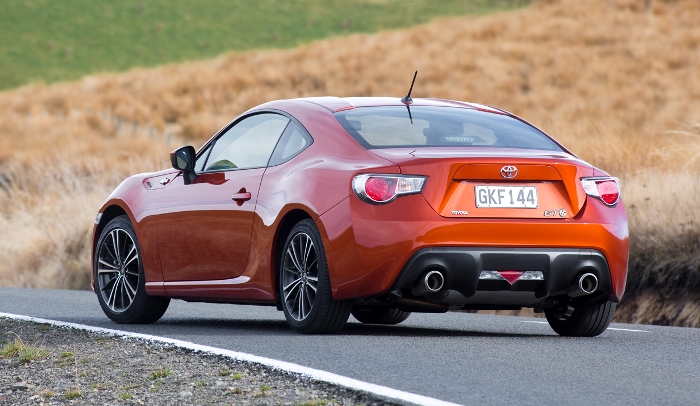
Car reviews
Read our expert car reviews - where we give insight into the latest vehicles to hit our roads.
24 August 2012
It might not be the most blisteringly fast thing out of the blocks, but it’s quick enough to be entertaining and it’s the whole package that makes the Toyota 86 as much fun as it is; performance, handling and styling in a great value package.

Who would have thought? The number one selling auto maker in New Zealand, with a reputation for building dependable little hatchbacks for rental companies or suburban mums and dads, and tough utes to Barry Crump-esque blokes, could come up with one of the most exciting sports cars to hit the streets in recent times.
Toyota has been a lot of things to a lot of people for a long time, but a maker of sublime handling stylish sports cars has not really been one of them. Until now.
The Toyota 86 is proof that nothing is beyond the world’s largest auto maker and that there is a good deal of passion bursting to break out of this seemingly volume-driven, otherwise very mainstream car company.
It must be acknowledged that the 86 has been co-developed with Subaru, who Toyota have had an alliance with since 2005 and whose equivalent model, the BRZ, is due for release in our market later in 2012. But it was Totoya’s Tetsuya Tada who was chief engineer on the project.
Tada had been working on the second generation of the Toyota Wish, a people-mover of all things, when he was chosen to lead the project in March 2007. “I was summoned to the executive suite during my lunch break and told that I needn’t concern myself with minivans any longer, and that I was to make a sports car instead. I had no idea what was going on, but I had a simple sense of happiness” he says.
The brief had been for a front engine, rear wheel drive (FR) layout, but the idea of using a boxer engine was cemented during Tada’s research into historic Toyota sports cars; in particular by studying blueprints of the 1960’s Toyota Sports 800, which had used a horizontally opposed FR layout. With the knowledge that Subaru would be involved with the project, this was shaping up to be a marriage made in heaven, because as every car enthusiast knows, Subaru has built an entire brand around horizontally opposed (boxer) engines which offer the benefit of a low centre of gravity, exactly what a sports car designer strives for.
The square (co-incidentally, 86mm bore/86mm stroke) flat 4 cylinder normally aspirated engine is mounted longitudinally in the front, driving the rear wheels through options of a 6 speed manual or 6 speed automatic transmission. The DOHC per bank, 16 valve VVT Subaru-derived engine uses a Toyota D4-S Direct Injection fuel system, and consumes a minimum of 95 octane fuel (although Toyota says that 98 is recommended) at the rate of 7.1L/100km for manual and 7.8L/100km in automatic guise.
A crisp, free revving engine, maximum power of 147kW is produced at 7,000rpm and 205Nm of torque at 6,400 – 6,600rpm. Acceleration is a respectable 7.6 seconds to 100km/h for manual and 8.2 seconds in the auto.
Weight distribution is close to even, with 53% front; 47% rear and in true sports car style, getting the power down via the rear wheels makes for predictable, balanced handling. Many electric power steering setups are plain awful, but the speed sensitive electronic power assisted steering in the 86 is one of the best around, with plenty of driver feedback giving a quick and responsive feel, as good, if not better than most old school hydraulic systems. With a 13.12:1 rack ratio, it requires 2.78 turns from lock to lock.
The 86 takes its name from the AE86, a sporty RWD Toyota from days gone by. Two main grades are available, the 86 and GT86, with the option of a TRD (Toyota Racing Developments) Special Edition upgrade for those wanting the all singing, dancing version.
The base model is fitted with 16 inch ten spoke alloys, with machined five spoke 17’s on the GT86. Braking is also upgraded for the GT86, with 294mm ventilated front and 290mm ventilated rear discs replacing the 86’s 277mm ventilated fronts and 286mm solid rears. The TRD upgrade includes huge 355mm fronts and 345mm rears as well as six pot Brembo callipers.
A factory fitted Aero Package can be optioned on the GT86, which includes bodywork styling enhancements including a massive rear boot spoiler which won’t be to everyone’s liking, with the boot spoiler in the TRD package being much more subtle and to our thinking, a lot more stylish by comparison.
The TRD kits are added here in New Zealand at Toyota’s facility in Thames, alongside the reconditioning facility for Toyota’s Signature Class cars. In addition to the bigger brakes, TRD upgrades include suspension, exhaust, body kit, 18 inch alloys, a four tip muffler that’s said to increase power by 5kW and TRD badges, starter button and various other little fancy tweaks. There’s also the all-important individually numbered plaque and Certificate of Authenticity.
Pricing starts at $41,986 for the manual 86 and $46,986 for the manual GT86, with automatic versions of both adding a $1,000 premium. TRD versions are priced from $63,486 to $69,486.
It might not be the most blisteringly fast thing out of the blocks, but it’s quick enough to be entertaining and it’s the whole package that makes the Toyota 86 as much fun as it is, with performance, handling and styling in a great value package.